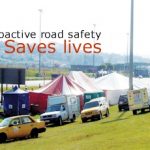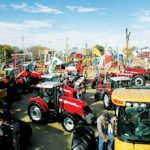Holy Trail
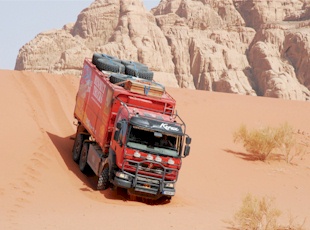
On 1 March, a convoy of Renaults left North Cape in Norway. Their mission? To cross 17 countries and three continents, and travel all the way down to Cape Town. Some 14 000 km into the trip, CHARLEEN CLARKE caught up with them in Jordan, a country known to many as the Holy Land…
I am black. Pitch black from head to toe, in fact. A rather unusual situation, considering my normally fair demeanour.The next minute, I am weightless. Floating 422 metres below sea level.
No, I have not gone completely nuts. Having plastered myself full of black mud, I am wallowing in the calm waters of the DeadSea…
Now I know what you’re thinking… What on earth does this have to do with trucks? Well, nothing actually. It’s just that I am passing time at the Dead Sea Spa Hotel, waiting for the convoy of Renaults taking part in the Cape to Cape Expedition. Resting before the storm, so to speak.
It was a good move, I decide the following morning. There’s a frantic amount of activity. The convoy of Renaults is lined up. Hordes of people are tossing their luggage onto the back of a Kerax. A short, dumpy and very grumpy journalist is screaming because he hasn’t had coffee and the convoy is leaving sans him tossing caffeine down his blubber-lined throat. It’s complete chaos.
I decide to sneak off to one of the Renault Sherpas, and grab a seat up front before they are all gone. The momentary respite also gives me a chance to inspect the 7.8 t GVW Sherpa firsthand.
I have not seen one of these Renaults in the metal before, which isn’t really surprising – the Sherpa has, in the past, been used exclusively by the military, either in passenger vehicle or pick-up guise (the former seats four and has a 2 to 3t payload; the latter boasts a flat bed that can accommodate a payload of 4.1 t. Like its military siblings, this civilian prototype (with an effective payload of 1.8 t) looks imposing. In fact, it makes the Hummer look like a car for hairdressers.
It’s big too. Some 5.3 m long, 2.35 m wide and 2.3 m high. And – as I was to discover later – extremely capable off road, with 630 mm of ground clearance and approach and departure angles of 60 and 50° respectively.
All too soon, I am joined by two journalists from the Czech Republic – one friendly and talkative, the other ominously silent. We are also joined by our driver, Christophe Guille, a demo driver from Renault. “We will do300 km today. We will be driving up into the mountains, then along the Dead Sea, then into the desert, then along some tracks. It will take the whole day,” he announces with a massive smile. I can see that he is loving the Cape to Cape, and he’s in no rush to reach Petra, our destination that night. With that, he fires up the vehicle’s 158 kW DXi 5 Euro 4/5 engine, selects drive on the automatic Allison transmission and we’re off.
The Sherpa does a maximum of 120 km/h but, given the fact that we are driving in a convoy that includes Kerax trucks, our progress is slow. This is a good thing– the scenery up above the Dead Sea is magnificent. Christophe tells me that he loves being in Jordan. “The people here are very friendly. In other places – Turkey, for instance, they walk with their heads down and may greet you eventually. In Jordan they walk with their heads up, they smile and wave straight away,” he comments. I soon concur – as we travel through towns, the locals smile and wave enthusiastically. And, when we stop at Wadi Mujib, we are greeted with numerous offers of tea. Jordan’s ‘Grand Canyon’, as the valley is known (‘wadi’ means ‘valley’), is indeed a sight to behold… I would encourage any avid traveller to visit this 220 km2 nature reserve, if not for the breathtaking views, then for the peace and quiet.
However, we cannot hang around and admire the vistas for too long – we still have to reach Petra, preferably before nightfall. And so the convoy soon moves off slowly.
About two hours before we reach our overnight stop, we venture off the track to play in the dunes. Christophe is in his element…He tackles the same dune over and over again, the Sherpa making ascent and descent quite effortless. One of the Kerax trucks gets stuck (only because the driver isn’t going fastenough to summit a dune) and there is much shouting in French and gesticulating at the unfortunate individual.
As we get close to the historical site of Petra, the road becomes narrow and tortuous. How tour buses pass by, I just don’t know. In just a few kilometres (of mostly hairpin bends), the vehicles climb from 420 m below sea level to almost 1 200 metres above.
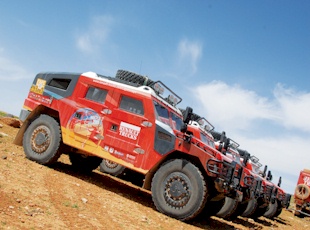
The following morning we rise early and the convoy drives a short way down the road to Petra. This time I hop into a Kerax 450.26 6×6, which has a GVW of 26t, apayload of 12t and is powered by the Euro4 Renault DXi, a 10.8-l motor that churns out331 kW of power and 2 140 Nm of torque.
The Kerax is ably piloted by the only lady driver in the current group – Valérie Bonnefoux, a petite and pretty 39-year-old from Renault’s sales office. The gearbox is the ZF16S 2220TO, and she manages it quite deftly, changing as though she has been doing this all her life. I am about to ask her about her experience driving trucks when we arrive at the ancient city of Petra.
A British journalist with the nickname of ‘Ding’, another of his countrymen with a fetish for G&Ts and yours truly tackle this truly unbelievable attraction. Ding isn’t keen – he says he cannot understand how anyone could ever get excited about a pile of rocks. Three hours later, Mr G&T and I have to haul him out of Petra by the lens of his Nikon… He’s still drooling over the pile of rocks and the convoy is about to depart. We’ve only tipped the iceberg in terms of visiting this sensational place. The site measures over 65 km and, if you want to see absolutely every rock, it would take a month.
Leaving Petra, we are peeved when we are unceremoniously led over to a dented old Nissan Patrol. We try to establish why we aren’t allowed in a Renault in some formor shape and discover that VIP customers have this privilege. Feeling rather precious and unloved, yours truly and the two British journalists grumble as we leave the busy little town of Petra and head in the direction of Wadi Rum.
But what a wonderful experience this turns out to be. Our driver – we call him Fangio – is undoubtedly completely insane. Either that or he’s a wannabe racing driver. Irrespective of the diagnosis, he drives like a man possessed, hurling the little Patrol at every dune and rock in sight. Once he has passed the entire convoy, he screeches to a halt, leaps out of the Patrol and we jump out to take photographs. So does a particularly rude Frenchman whom the Poms name David Bailey. David believes that he is the one and only photographer who deserves to get a good shot and if anyone stands anywhere close, he yells “S’il vous plait!” and gesticulates madly. I wonder if he has been spending time with Fangio…
Once the convoy has rumbled past, we tumble back into the Patrol with Fangio and then it’s another mad dash to the next photographic point. When another Nissan Patrol tries to pass Fangio,the sclerosis of the brain becomes markedly more apparent – and his driving goes from bad to utterly horrific. I keep on wondering when he is going to toss the vehicle over, when the Patrol will simply die or when we could meet the same fate. None of these scenarios materialise and it’s all such great fun. I am ever so impressed at the ladder chassis of the Patrol – Fangio seems unable to break the vehicle, despite his most arduous efforts.
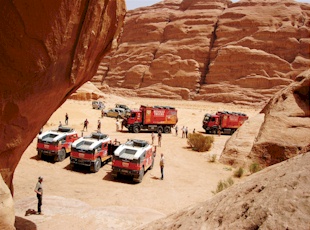
The next time, we dilly dally while the technicians potter over Sherpa2, which has been the problem child of the trip (each of the vehicles has a number). The Sherpas are all prototypes that are being tested on the Cape to Cape, so it is expected that things will go wrong. But, whereas the other Sherpas and all the Kerax trucks have not missed a beat, Sherpa 2 clearly didn’t relish the idea of being away from home. Even the fridge in the back of the vehicle stopped working en route and one of the windows ceased to function.The consensus among the group is that it is jinxed.
While the technicians attend to the rogue Sherpa, we decide to fill up our memory cards with photographs of the various vehicles – to the ire of David Bailey, who has subsequently been rechristened David Bloody Bailey by the Poms. As we trundle up and down the dunes taking pics (the vehicles present such an imposing sight), all we can hear is screams of “S’il vous plait!” from the now hysterical French photographer.
Once the technicians have completed their job and David Bailey has finished erupting, we leave our magical campsite in Wadi Rum. I am in another of the Kerax 6x6s, piloted this time by Jérôme Oliver, an Englishman who is responsible for analysing competitors’ vehicles at Renault. He’s done 7 000 km of the journey thus far and confesses that he misses his Russian girlfriend (who happens to be pregnant with their first child) as well as his privacy.
Other than that, he’s having the time of his life – and he’s ever so glad he was selected to do the expedition. Jérôme explains that the drivers all went through an extensive selection process – and he wasn’t actually selected in the first round. “It was a lucky draw,” he explains. “Everyone who wanted to come on the expedition applied and 100 names were quite literally drawn out of a hat. I was incredibly fortunate. One of the guys who was selected wasn’t available, so they drew one more name – and that was mine!”
After the draw, the applicants participated in a selection weekend, when their driving ability was tested as were their leadership skills. “We also had a medical and then the 100 applicants were narrowed down to 30,”says Jérôme.
We drive for 60 km in Wadi Rum and Jérôme is both informative and chilled, allowing us to stop regularly to take photographs. He snaps away while driving too, mentioning that he has taken thousands upon thousands of photographs while en route. “My girlfriend is complaining; every time I send her a pic,there’s always a truck right in the centre of it,” he says.
Incredibly, Jérôme reveals that the tyres have not been changed during the trip.“Irrespective of the conditions… tar roads, snow, sand… we have kept the same tyres.They have been great.” The vehicles are shod with Michelins from the XZL range.
He also explains that the trucks are standard. “We only modified the suspension slightly, fitted racing shocks and added an extra fuel tank.”
As we approach the Gulf of Aqaba and the conclusion of our time with the convoy, I ask Jérôme if the trip was extremely challenging for him personally. “No – but, then again, Iam a bit of a nutter. Some of my friends are horrified if they put their foot in a puddle; I like challenges such as mountaineering. I enjoy suffering,” he says with a laugh.
And what of the challenge for the vehicles? The Kerax trucks have, after all, performed faultlessly. “The Kerax is my favourite truck in the range and it’s incredibly strong. We have actually tortured these vehicles and they have come through. But I never doubted that they would make it…”
Published by
Focus on Transport
focusmagsa

